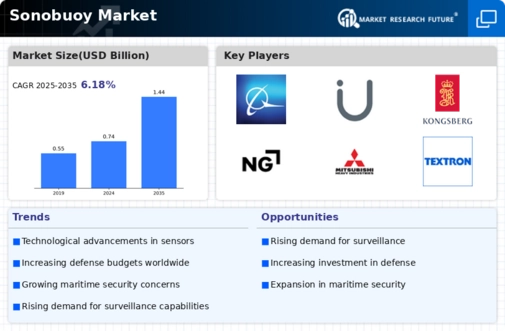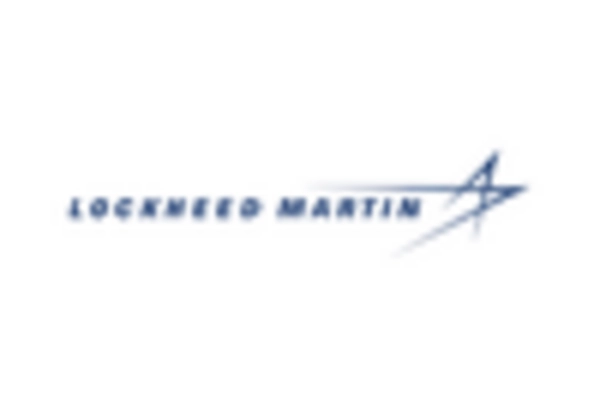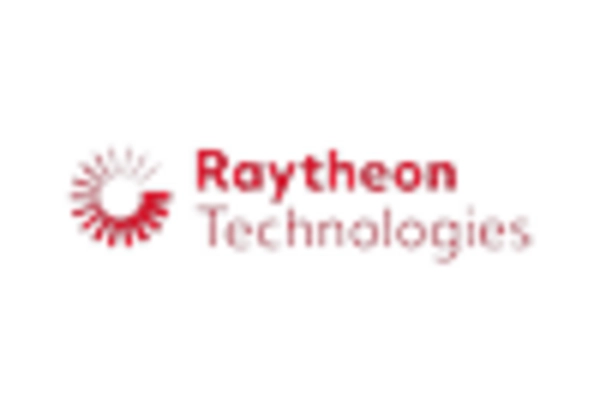Market Share
Introduction: Navigating the Competitive Currents of the Sonobuoy Market
The sonobuoy market is experiencing a transformative phase, driven by rapid technology adoption and evolving regulatory landscapes that demand enhanced surveillance capabilities. Key players, including OEMs, IT integrators, and specialized AI startups, are fiercely competing for market leadership by leveraging advanced analytics, automation, and IoT integration. OEMs are focusing on developing next-generation sonobuoys equipped with AI-based analytics to improve data accuracy and operational efficiency, while IT integrators are enhancing interoperability across platforms to meet stringent defense requirements. Emerging disruptors are introducing innovative solutions that prioritize green infrastructure and sustainability, aligning with global environmental standards. As regional growth opportunities expand, particularly in Asia-Pacific and North America, strategic deployment trends for 2024–2025 will increasingly favor partnerships that enhance technological capabilities and operational readiness, positioning agile vendors to capture significant market share.
Competitive Positioning
Full-Suite Integrators
These vendors offer comprehensive solutions encompassing design, manufacturing, and integration of sonobuoy systems.
| Vendor | Competitive Edge | Solution Focus | Regional Focus |
|---|---|---|---|
| Boeing | Strong aerospace capabilities | Integrated defense systems | Global |
| Northrop Grumman | Advanced sensor technology | Defense and aerospace solutions | North America, Europe |
| Lockheed Martin | Leading defense contractor | Military systems and solutions | Global |
| Raytheon Technologies | Innovative radar and sensor systems | Defense and aerospace technologies | Global |
| L3Harris Technologies | Communication and electronic systems | Integrated communication solutions | Global |
Specialized Technology Vendors
These companies focus on niche technologies and solutions specifically tailored for sonobuoy applications.
| Vendor | Competitive Edge | Solution Focus | Regional Focus |
|---|---|---|---|
| Ultra Electronics | Expertise in underwater systems | Sonar and underwater technology | Global |
| Kongsberg Gruppen | Strong maritime technology focus | Marine and defense systems | Europe, North America |
| Thales Group | Innovative defense solutions | Electronics and defense systems | Global |
| Elbit Systems | Advanced defense electronics | Defense and security solutions | Global |
| Leonardo S.p.A | Strong European defense presence | Aerospace and defense systems | Europe, Middle East |
Infrastructure & Equipment Providers
These vendors supply the necessary infrastructure and equipment to support sonobuoy operations.
| Vendor | Competitive Edge | Solution Focus | Regional Focus |
|---|---|---|---|
| General Dynamics | Robust defense infrastructure | Defense and technology solutions | North America, Europe |
| Harris Corporation | Communication technology expertise | Communication and electronic systems | North America |
| Mitsubishi Heavy Industries | Diverse industrial capabilities | Heavy machinery and defense systems | Asia, Global |
| Textron | Diverse portfolio of products | Aerospace and defense solutions | North America, Global |
Emerging Players & Regional Champions
- OceanSonics (Canada): Specializes in advanced acoustic monitoring solutions, recently secured a contract with the Canadian Navy for deploying their next-gen sonobuoys, challenging established vendors by offering more cost-effective and flexible solutions.
- Thales Group (France): Offers innovative sonobuoy systems with integrated data analytics, recently implemented a project with the French Navy to enhance maritime surveillance, complementing established players by providing advanced technology and interoperability.
- Ultra Electronics (UK): Focuses on bespoke sonobuoy designs tailored for specific operational needs, recently partnered with the UK Ministry of Defence for a pilot program, positioning itself as a challenger to larger firms by emphasizing customization and rapid deployment.
- Kongsberg Gruppen (Norway): Provides cutting-edge sonobuoy technology with a focus on environmental monitoring, recently entered a collaboration with the Norwegian Coast Guard, enhancing their competitive edge against traditional manufacturers by integrating environmental data capabilities.
Regional Trends: In 2023, there is a notable increase in regional adoption of sonobuoy technology, particularly in North America and Europe, driven by heightened maritime security concerns and environmental monitoring needs. Companies are specializing in integrating AI and data analytics into sonobuoy systems, enhancing operational efficiency and decision-making capabilities. Additionally, there is a trend towards customization and flexibility in sonobuoy designs to meet specific regional requirements.
Collaborations & M&A Movements
- Ultra Electronics and Northrop Grumman entered into a partnership to develop next-generation sonobuoy systems aimed at enhancing anti-submarine warfare capabilities, thereby strengthening their competitive positioning in the defense sector.
- Leonardo S.p.A. acquired a minority stake in a tech startup specializing in advanced sonar technologies to integrate innovative solutions into their existing sonobuoy offerings, enhancing their market share in the naval defense industry.
- Raytheon Technologies and BAE Systems collaborated to create a new line of sonobuoys that utilize artificial intelligence for improved target detection, positioning themselves as leaders in the evolving maritime surveillance market.
Competitive Summary Table
| Capability | Leading Players | Remarks |
|---|---|---|
| Acoustic Detection | Thales Group, Lockheed Martin | Thales Group has advanced acoustic processing algorithms that enhance detection capabilities in complex underwater environments. Lockheed Martin's sonobuoys are integrated with advanced signal processing technology, allowing for real-time data analysis and improved target tracking. |
| Data Transmission | Northrop Grumman, Raytheon | Northrop Grumman's sonobuoys feature robust data transmission systems that ensure reliable communication in challenging conditions. Raytheon's innovations in low-latency data links have significantly improved the speed and reliability of information relay from deployed sonobuoys. |
| Multi-Role Functionality | Boeing, General Dynamics | Boeing's sonobuoys are designed for multi-role applications, including anti-submarine warfare and environmental monitoring, showcasing versatility. General Dynamics has developed modular sonobuoy systems that can be easily adapted for various missions, enhancing operational flexibility. |
| Sustainability | L3Harris Technologies, Ultra Electronics | L3Harris Technologies is focusing on eco-friendly materials in their sonobuoy production, aiming to reduce environmental impact. Ultra Electronics has implemented sustainable practices in their manufacturing processes, which have been recognized in recent environmental assessments. |
| Integration with Autonomous Systems | SAAB, Leonardo | SAAB has successfully integrated sonobuoys with unmanned underwater vehicles (UUVs), enhancing operational capabilities in maritime surveillance. Leonardo's systems are designed to work seamlessly with autonomous platforms, providing enhanced situational awareness and operational efficiency. |
Conclusion: Navigating Sonobuoy Market Dynamics
The Sonobuoy market in 2023 is characterized by intense competitive dynamics and significant fragmentation, with both legacy and emerging players vying for market share. Regional trends indicate a growing emphasis on advanced capabilities, particularly in AI and automation, which are becoming critical differentiators for vendors. Legacy players are leveraging their established reputations and extensive networks, while emerging companies are focusing on innovative solutions that emphasize sustainability and flexibility. As the market evolves, the ability to integrate these capabilities will be paramount for leadership, compelling all vendors to adapt their strategies to meet the changing demands of defense and maritime applications.

















Leave a Comment